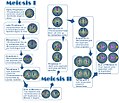Reproduction
Reproduction is a biological process by which new individuals of the same species are produced, either by a single parent (asexual reproduction) or by two parents (sexual reproduction). This process is fundamental to all life forms, ensuring their survival and allowing for genetic diversity.
Types of Reproduction[edit]
There are two main types of reproduction: asexual and sexual.
Asexual Reproduction[edit]
Asexual reproduction is a type of reproduction where one parent organism can reproduce without the involvement of another organism. Asexual reproduction results in offspring that are genetically identical to the parent organism because the offspring are all clones of the original parent.
Sexual Reproduction[edit]
Sexual reproduction is a type of reproduction that involves the combination of genetic material from two parents to produce offspring. These offspring are genetically different from their parents, which leads to increased genetic diversity.
Mechanisms of Reproduction[edit]
Different organisms use different mechanisms for reproduction, depending on their biological characteristics and their environment.
Fission[edit]
Fission is a form of asexual reproduction where an organism splits into two or more organisms.
Budding[edit]
Budding is another form of asexual reproduction where a new organism grows out of the body of the parent organism.
Spore Formation[edit]
Spore formation is a form of asexual reproduction where an organism produces spores that can develop into new individuals.
Gamete Formation[edit]
Gamete formation is a form of sexual reproduction where two cells (usually an egg and a sperm) combine to form a new individual.
See Also[edit]
Ad. Transform your life with W8MD's Budget GLP-1 injections from $75


W8MD offers a medical weight loss program to lose weight in Philadelphia. Our physician-supervised medical weight loss provides:
- Weight loss injections in NYC (generic and brand names):
- Zepbound / Mounjaro, Wegovy / Ozempic, Saxenda
- Most insurances accepted or discounted self-pay rates. We will obtain insurance prior authorizations if needed.
- Generic GLP1 weight loss injections from $75 for the starting dose.
- Also offer prescription weight loss medications including Phentermine, Qsymia, Diethylpropion, Contrave etc.
NYC weight loss doctor appointmentsNYC weight loss doctor appointments
Start your NYC weight loss journey today at our NYC medical weight loss and Philadelphia medical weight loss clinics.
- Call 718-946-5500 to lose weight in NYC or for medical weight loss in Philadelphia 215-676-2334.
- Tags:NYC medical weight loss, Philadelphia lose weight Zepbound NYC, Budget GLP1 weight loss injections, Wegovy Philadelphia, Wegovy NYC, Philadelphia medical weight loss, Brookly weight loss and Wegovy NYC
|
WikiMD's Wellness Encyclopedia |
| Let Food Be Thy Medicine Medicine Thy Food - Hippocrates |
Medical Disclaimer: WikiMD is not a substitute for professional medical advice. The information on WikiMD is provided as an information resource only, may be incorrect, outdated or misleading, and is not to be used or relied on for any diagnostic or treatment purposes. Please consult your health care provider before making any healthcare decisions or for guidance about a specific medical condition. WikiMD expressly disclaims responsibility, and shall have no liability, for any damages, loss, injury, or liability whatsoever suffered as a result of your reliance on the information contained in this site. By visiting this site you agree to the foregoing terms and conditions, which may from time to time be changed or supplemented by WikiMD. If you do not agree to the foregoing terms and conditions, you should not enter or use this site. See full disclaimer.
Credits:Most images are courtesy of Wikimedia commons, and templates, categories Wikipedia, licensed under CC BY SA or similar.
Translate this page: - East Asian
中文,
日本,
한국어,
South Asian
हिन्दी,
தமிழ்,
తెలుగు,
Urdu,
ಕನ್ನಡ,
Southeast Asian
Indonesian,
Vietnamese,
Thai,
မြန်မာဘာသာ,
বাংলা
European
español,
Deutsch,
français,
Greek,
português do Brasil,
polski,
română,
русский,
Nederlands,
norsk,
svenska,
suomi,
Italian
Middle Eastern & African
عربى,
Turkish,
Persian,
Hebrew,
Afrikaans,
isiZulu,
Kiswahili,
Other
Bulgarian,
Hungarian,
Czech,
Swedish,
മലയാളം,
मराठी,
ਪੰਜਾਬੀ,
ગુજરાતી,
Portuguese,
Ukrainian






